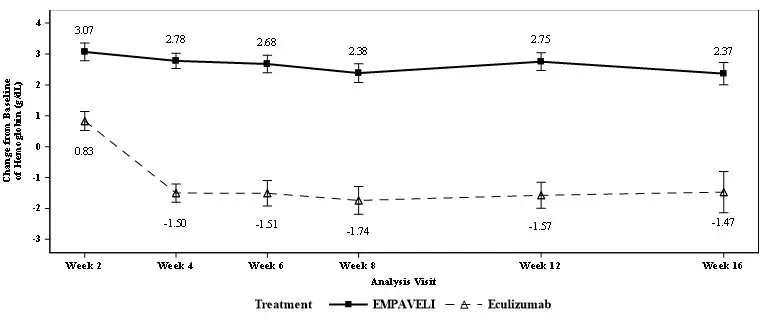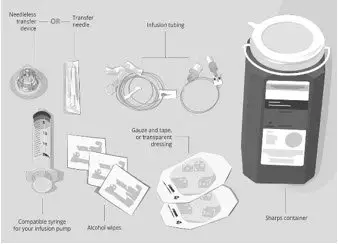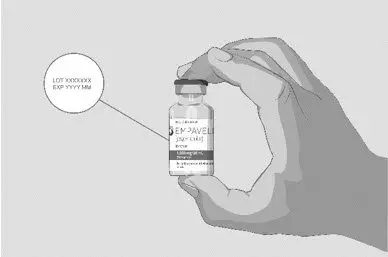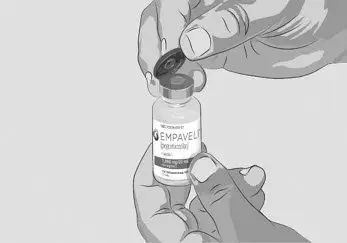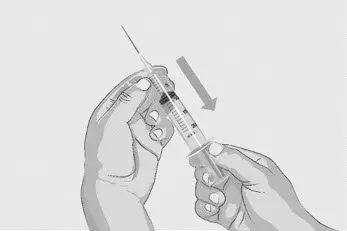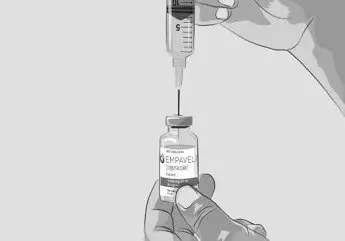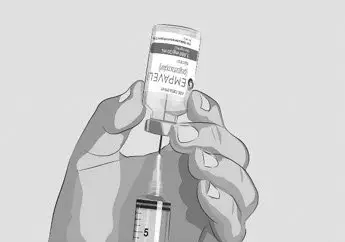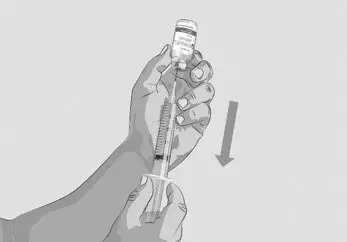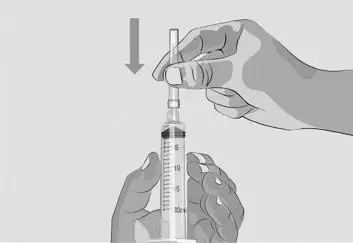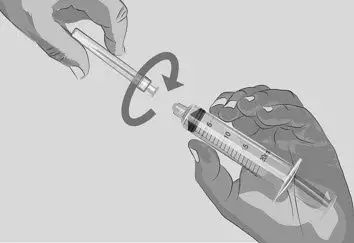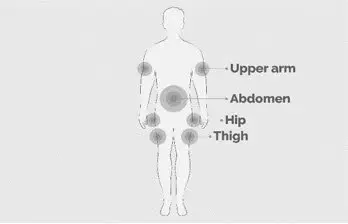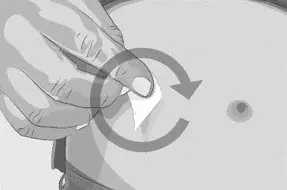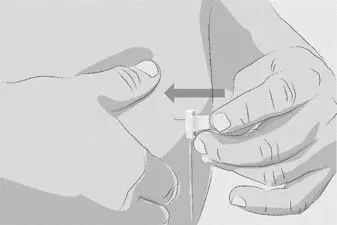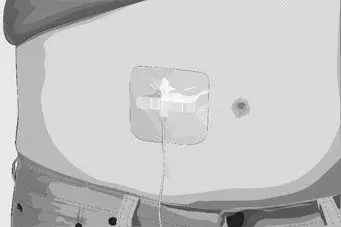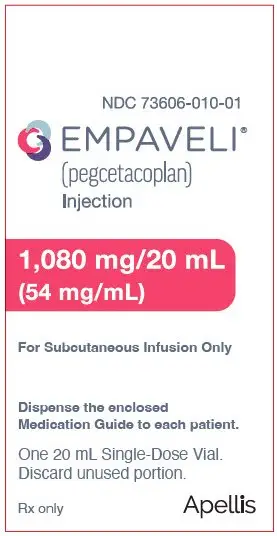Drug Detail:Empaveli (Pegcetacoplan)
Drug Class: Selective immunosuppressants
Highlights of Prescribing Information
EMPAVELI® (pegcetacoplan) injection, for subcutaneous use
Initial U.S. Approval: 2021
WARNING: SERIOUS INFECTIONS CAUSED BY ENCAPSULATED BACTERIA
See full prescribing information for complete boxed warning.
Meningococcal infections may occur in patients treated with EMPAVELI and may become rapidly life-threatening or fatal if not recognized and treated early. Use of EMPAVELI may predispose individuals to serious infections, especially those caused by encapsulated bacteria, such as Streptococcus pneumoniae, Neisseria meningitidis types A, C, W, Y, and B, and Haemophilus influenzae type B. (5.1)
- Comply with the most current Advisory Committee on Immunization Practices (ACIP) recommendations for vaccinations against encapsulated bacteria. (5.1)
- Vaccinate patients against encapsulated bacteria as recommended at least 2 weeks prior to administering the first dose of EMPAVELI unless the risks of delaying EMPAVELI therapy outweigh the risks of developing a serious infection. See Warnings and Precautions (5.1) for additional guidance on managing the risk of serious infections.
- Vaccination reduces, but does not eliminate, the risk of serious infections. Monitor patients for early signs of serious infections and evaluate immediately if infection is suspected. (5.1)
EMPAVELI is available only through a restricted program under a Risk Evaluation and Mitigation Strategy (REMS). Under the EMPAVELI REMS, prescribers must enroll in the program. (5.2)
Indications and Usage for Empaveli
EMPAVELI is a complement inhibitor indicated for the treatment of adult patients with paroxysmal nocturnal hemoglobinuria (PNH). (1)
Empaveli Dosage and Administration
- Recommended dosage is 1,080 mg by subcutaneous infusion twice weekly via a commercially available pump. (2.2)
- See Full Prescribing Information for instructions on preparation and administration. (2.2, 2.3)
Dosage Forms and Strengths
- Injection: 1,080 mg/20 mL (54 mg/mL) in a single-dose vial. (3)
Contraindications
EMPAVELI is contraindicated in:
- Patients with hypersensitivity to pegcetacoplan or any of the excipients. (4)
- Patients who are not currently vaccinated against certain encapsulated bacteria unless the risks of delaying EMPAVELI treatment outweigh the risks of developing a serious bacterial infection with an encapsulated organism. (4, 5.1)
- Patients with unresolved serious infection caused by encapsulated bacteria. (4)
Warnings and Precautions
Use caution when administering EMPAVELI to patients with:
- Serious infections caused by encapsulated bacteria. (5.1)
- Infusion-Related Reactions: Monitor patients for infusion-related reactions and institute appropriate medical management as needed. (5.3)
- Interference with Laboratory Tests: Use of silica reagents in coagulation panels may result in artificially prolonged activated partial thromboplastin time (aPTT). (5.5)
Adverse Reactions/Side Effects
Most common adverse reactions in patients with PNH (incidence ≥10%) were injection-site reactions, infections, diarrhea, abdominal pain, respiratory tract infection, pain in extremity, hypokalemia, fatigue, viral infection, cough, arthralgia, dizziness, headache, and rash. (6.1)
To report SUSPECTED ADVERSE REACTIONS, contact Apellis Pharmaceuticals, Inc. at 1-833-866-3346 or FDA at 1-800-FDA-1088 or www.fda.gov/medwatch.
See 17 for PATIENT COUNSELING INFORMATION and Medication Guide.
Revised: 2/2023
Full Prescribing Information
WARNING: SERIOUS INFECTIONS CAUSED BY ENCAPSULATED BACTERIA
Meningococcal infections may occur in patients treated with EMPAVELI and may become rapidly life-threatening or fatal if not recognized and treated early. Use of EMPAVELI may predispose individuals to serious infections, especially those caused by encapsulated bacteria, such as Streptococcus pneumoniae, Neisseria meningitidis types A, C, W, Y, and B, and Haemophilus influenzae type B [see Warnings and Precautions (5.1)].
- Comply with the most current Advisory Committee on Immunization Practices (ACIP) recommendations for vaccinations against encapsulated bacteria in patients with altered immunocompetence associated with complement deficiencies.
- Vaccinate patients against encapsulated bacteria as recommended at least 2 weeks prior to administering the first dose of EMPAVELI unless the risks of delaying therapy with EMPAVELI outweigh the risk of developing a serious infection. See Warnings and Precautions (5.1) for additional guidance on the management of the risk of serious infections.
- Vaccination reduces, but does not eliminate, the risk of serious infections. Monitor patients for early signs of serious infections and evaluate immediately if infection is suspected.
EMPAVELI is available only through a restricted program under a Risk Evaluation and Mitigation Strategy (REMS). Under the EMPAVELI REMS, prescribers must enroll in the program [see Warnings and Precautions (5.2)]. Enrollment in the EMPAVELI REMS program and additional information are available by telephone: 1-888-343-7073 or at www.empavelirems.com.
1. Indications and Usage for Empaveli
EMPAVELI® is indicated for the treatment of adult patients with paroxysmal nocturnal hemoglobinuria (PNH).
2. Empaveli Dosage and Administration
2.1 Recommended Vaccination and Prophylaxis
Vaccinate patients against encapsulated bacteria, including Streptococcus pneumoniae, Neisseria meningitidis, and Haemophilus influenzae type B at least 2 weeks prior to initiation of EMPAVELI therapy according to current ACIP guidelines [see Warnings and Precautions (5.1)].
Provide 2 weeks of antibacterial drug prophylaxis to patients if EMPAVELI must be initiated immediately and vaccines are administered less than 2 weeks before starting therapy with EMPAVELI.
Healthcare professionals who prescribe EMPAVELI must enroll in the REMS for EMPAVELI [see Warnings and Precautions (5.2)].
2.2 Dosage
The recommended dose of EMPAVELI is 1,080 mg by subcutaneous infusion twice weekly via a commercially available infusion pump with a reservoir of at least 20 mL.
2.3 Administration
EMPAVELI is for subcutaneous infusion using an infusion pump.
EMPAVELI is intended for use under the guidance of a healthcare professional. After proper training in subcutaneous infusion, a patient may self-administer, or the patient's caregiver may administer EMPAVELI, if a healthcare provider determines that it is appropriate.
- Refer to the EMPAVELI Instructions for Use and the infusion pump manufacturer's instructions for full preparation and administration information.
- Use aseptic technique when preparing and administering EMPAVELI.
- Prior to use‚ allow EMPAVELI to reach room temperature for approximately 30 minutes. Keep the vial in the carton until ready for use to protect from light.
- Parenteral drug products should be inspected visually for particulate matter and discoloration prior to administration, whenever solution and container permit. EMPAVELI is a clear, colorless to slightly yellowish solution. Do not use if the liquid looks cloudy, contains particles, or is dark yellow.
- Use a needleless transfer device (such as a vial adapter) or a transfer needle to fill the syringe.
- Rotate infusion sites (i.e., abdomen, thighs, hips, upper arms) from one infusion to the next. Do not infuse where the skin is tender, bruised, red, or hard. Avoid infusing into tattoos, scars, or stretch marks.
- If multi-infusion sets are needed, ensure the infusion sites are at least 3 inches apart.
- The typical infusion time is approximately 30 minutes (if using two infusion sites) or approximately 60 minutes (if using one infusion site).
- Discard any unused portion.
3. Dosage Forms and Strengths
Injection: 1,080 mg/20 mL (54 mg/mL) clear, colorless to slightly yellowish solution in a single-dose vial.
4. Contraindications
EMPAVELI is contraindicated in:
- Patients with hypersensitivity to pegcetacoplan or to any of the excipients.
- Patients who are not currently vaccinated against certain encapsulated bacteria, unless the risks of delaying EMPAVELI treatment outweigh the risks of developing a bacterial infection with an encapsulated organism [see Warnings and Precautions (5.1)].
- Patients with unresolved serious infection caused by encapsulated bacteria including Streptococcus pneumoniae, Neisseria meningitidis, and Haemophilus influenzae.
5. Warnings and Precautions
5.1 Serious Infections Caused by Encapsulated Bacteria
The use of EMPAVELI may predispose individuals to serious, life-threatening, or fatal infections caused by encapsulated bacteria including Streptococcus pneumoniae, Neisseria meningitidis types A, C, W, Y, and B, and Haemophilus influenzae type B (Hib). To reduce the risk of infection, all patients must be vaccinated against these bacteria according to the most current ACIP recommendations for patients with altered immunocompetence associated with complement deficiencies. Revaccinate patients in accordance with ACIP recommendations considering the duration of therapy with EMPAVELI.
For patients without known history of vaccination, administer required vaccines at least 2 weeks prior to receiving the first dose of EMPAVELI. If immediate therapy with EMPAVELI is indicated, administer required vaccine as soon as possible and provide patients with 2 weeks of antibacterial drug prophylaxis.
Closely monitor patients for early signs and symptoms of serious infection and evaluate patients immediately if an infection is suspected. Promptly treat known infections. Serious infection may become rapidly life-threatening or fatal if not recognized and treated early. Consider discontinuation of EMPAVELI in patients who are undergoing treatment for serious infections.
5.2 EMPAVELI REMS
Because of the risk of serious infections, EMPAVELI is available only through a restricted program under a REMS. Under the EMPAVELI REMS, prescribers must enroll in the program.
Prescribers must counsel patients about the risk of serious infection, provide the patients with the REMS educational materials, and ensure patients are vaccinated against encapsulated bacteria.
Enrollment in the EMPAVELI REMS and additional information are available by telephone: 1-888-343-7073 or at www.empavelirems.com.
5.3 Infusion-Related Reactions
Systemic hypersensitivity reactions (e.g., facial swelling, rash, urticaria) have occurred in patients treated with EMPAVELI. One patient (less than 1% in clinical studies) experienced a serious allergic reaction which resolved after treatment with antihistamines. If a severe hypersensitivity reaction (including anaphylaxis) occurs, discontinue EMPAVELI infusion immediately, institute appropriate treatment, per standard of care, and monitor until signs and symptoms are resolved.
5.4 Monitoring PNH Manifestations after Discontinuation of EMPAVELI
After discontinuing treatment with EMPAVELI, closely monitor for signs and symptoms of hemolysis, identified by elevated LDH levels along with sudden decrease in PNH clone size or hemoglobin, or reappearance of symptoms such as fatigue, hemoglobinuria, abdominal pain, dyspnea, major adverse vascular events (including thrombosis), dysphagia, or erectile dysfunction. Monitor any patient who discontinues EMPAVELI for at least 8 weeks to detect hemolysis and other reactions. If hemolysis, including elevated LDH, occurs after discontinuation of EMPAVELI, consider restarting treatment with EMPAVELI.
6. Adverse Reactions/Side Effects
The following clinically significant adverse reactions are discussed in greater detail in other sections of the labeling:
- Serious Infections Caused by Encapsulated Bacteria [see Warnings and Precautions (5.1)]
- Infusion-Related Reactions [see Warnings and Precautions (5.3)]
6.1 Clinical Trials Experience
Because clinical trials are conducted under widely varying conditions, adverse reaction rates observed in the clinical trials of a drug cannot be directly compared to rates in the clinical trials of another drug and may not reflect the rates observed in practice.
Paroxysmal Nocturnal Hemoglobinuria
Study in Complement-Inhibitor Experienced Adult Patients with PNH (Study APL2-302)
The data described below reflect the exposure in 80 adult patients with PNH who received EMPAVELI (n=41) or eculizumab (n=39) at the recommended dosing regimens for 16 weeks. Serious adverse reactions were reported in 7 (17%) patients with PNH receiving EMPAVELI. The most common serious adverse reaction in patients treated with EMPAVELI was infections (5%). The most common adverse reactions (≥10%) with EMPAVELI were injection-site reactions, infections, diarrhea, abdominal pain, respiratory tract infection, viral infection, and fatigue.
Table 1 describes the adverse reactions that occurred in ≥5% of patients treated with EMPAVELI in Study APL2-302.
| Adverse Reaction | EMPAVELI (N=41) n (%) | Eculizumab (N=39) n (%) |
|---|---|---|
|
||
| General disorders and administration site conditions | ||
| Injection-site reaction* | 16 (39) | 2 (5) |
| Fatigue* | 5 (12) | 9 (23) |
| Chest pain* | 3 (7) | 1 (3) |
| Infections and infestations | ||
| Infections* | 12 (29) | 10 (26) |
| Respiratory tract infection* | 6 (15) | 5 (13) |
| Viral Infection* | 5 (12) | 3 (8) |
| Gastrointestinal disorders | ||
| Diarrhea | 9 (22) | 1 (3) |
| Abdominal pain* | 8 (20) | 4 (10) |
| Musculoskeletal disorders | ||
| Back pain* | 3 (7) | 4 (10) |
| Nervous system disorders | ||
| Headache | 3 (7) | 9 (23) |
| Vascular disorders | ||
| Systemic hypertension* | 3 (7) | 1 (3) |
Study in Complement-Inhibitor Naïve Adult Patients with PNH (Study APL2-308)
The data described below reflect the exposure in adult patients with PNH who received EMPAVELI (n=46) or the control arm (supportive care excluding complement inhibitors) (n=18) in Study APL2-308 [see Clinical Studies (14.1)]. One patient (2%) who received EMPAVELI died due to septic shock. Serious adverse reactions were reported in 6 (13%) patients with PNH receiving EMPAVELI. The most common adverse reaction (≥10%) in patients treated with EMPAVELI were injection site reactions, infections, viral infection, pain in extremity, hypokalemia, arthralgia, dizziness, abdominal pain, rash, and headache.
Table 2 describes the adverse reactions that occurred in ≥5% of patients treated with EMPAVELI in Study APL2‑308.
| Adverse Reaction | EMPAVELI (N=46) n (%) | Control Arm*
(N=18) n (%) |
|---|---|---|
| Exposure Adjusted Rate (per 100 pt yrs) | Exposure Adjusted Rate (per 100 pt yrs) | |
| EMPAVELI (N=46) group includes patients who received EMPAVELI at any point during the study, including patients randomized to EMPAVELI (N=35) and patients randomized to the control arm and crossed over to EMPAVELI treatment (N=11). | ||
|
||
| General disorders and administration site conditions | ||
| Injection-site reaction† | 12 (26) 42 | 0 0 |
| Pyrexia | 4(9) 14 | 0 0 |
| Peripheral edema† | 3 (7) 11 | 0 0 |
| Infections and Infestations | ||
| Infections† | 9 (20) 32 | 4 (22) 74 |
| Viral infection† | 6 (13) 21 | 2 (11) 37 |
| Musculoskeletal and connective tissue disorders | ||
| Pain in extremity | 6 (13) 21 | 0 0 |
| Arthralgia | 5 (11) 18 | 0 0 |
| Musculoskeletal pain | 3 (7) 11 | 0 0 |
| Metabolism and nutrition disorders | ||
| Hypokalemia | 6 (13) 21 | 2 (11) 37 |
| Nervous system disorders | ||
| Dizziness | 5 (11) 18 | 0 0 |
| Headache | 5 (11) 18 | 0 0 |
| Somnolence | 3 (7) 11 | 0 0 |
| Gastrointestinal disorders | ||
| Abdominal pain† | 5 (11) 18 | 1 (6) 18 |
| Skin and subcutaneous tissue disorders | ||
| Rash† | 5(11) 18 | 0 0 |
| Ecchymosis | 3 (7) 11 | 0 0 |
| Erythema | 3 (7) 11 | 0 0 |
| Blood and lymphatic system disorders | ||
| Thrombocytopenia | 3 (7) 11 | 1 (6) 18 |
| Respiratory, thoracic and mediastinal disorders | ||
| Cough† | 4 (9) 14 | 0 0 |
| Epistaxis | 3 (7) 11 | 0 0 |
| Investigations | ||
| Blood creatinine increased | 3 (7) 11 | 0 0 |
8. Use In Specific Populations
11. Empaveli Description
EMPAVELI contains pegcetacoplan, a complement inhibitor. Pegcetacoplan is a symmetrical molecule comprised of two identical pentadecapeptides covalently bound to the ends of a linear 40-kiloDalton (kDa) PEG molecule. The peptide portions of pegcetacoplan contain 1-methyl-L-tryptophan (Trp(Me)) in position 4 and amino(ethoxyethoxy)acetic acid (AEEA) in position 14.
The molecular weight of pegcetacoplan is approximately 43.5 kDa. The molecular formula is C1970H3848N50O947S4. The structure of pegcetacoplan is shown below.

EMPAVELI injection is a sterile, clear, colorless to slightly yellowish aqueous solution for subcutaneous use and is supplied in a 20-mL single-dose vial. Each 1 mL of solution contains 54 mg of pegcetacoplan, 41 mg of sorbitol, 0.384 mg of glacial acetic acid, 0.490 mg of sodium acetate trihydrate, and Water for Injection USP. EMPAVELI may also contain sodium hydroxide and/or additional glacial acetic acid for adjustment to a target pH of 5.0.
12. Empaveli - Clinical Pharmacology
12.1 Mechanism of Action
Pegcetacoplan binds to complement protein C3 and its activation fragment C3b, thereby regulating the cleavage of C3 and the generation of downstream effectors of complement activation. In PNH, extravascular hemolysis (EVH) is facilitated by C3b opsonization while intravascular hemolysis (IVH) is mediated by the downstream membrane attack complex (MAC). Pegcetacoplan acts proximally in the complement cascade controlling both C3b-mediated EVH and terminal complement-mediated IVH.
12.2 Pharmacodynamics
In patients with PNH administered multiple doses of pegcetacoplan, the mean C3 concentration increased from 0.94 g/L at baseline to 3.80 g/L at Week 16 and sustained through Week 48 (Study APL2-302). In study APL2-308, the mean C3 concentration increased from 0.95 g/L at baseline to 3.56 g/L at Week 26 [see Clinical Studies (14.1)].
The percentage of PNH Type II + III RBCs increased from 66.2% at baseline to 93.9% at Week 16 and sustained through Week 48 (Study APL2-302). In Study APL2-308, the mean percentage of PNH Type II + III RBCs increased from 42.4% at baseline to 90.0% at Week 26.
The mean percentage of PNH Type II + III RBCs with C3 deposition decreased from 17.8% at baseline to 0.20% at Week 16 and sustained through Week 48 (Study APL2-302). In Study APL2-308, the mean percentage of PNH Type II + III RBCs with C3 deposition decreased from 2.85% at baseline to 0.09% at Week 26.
12.3 Pharmacokinetics
In patients with PNH, the serum pegcetacoplan concentrations achieved steady-state approximately 4 to 6 weeks following the first dose. The exposure of pegcetacoplan increased proportionally over a dose range from 45 to 1,440 mg (0.04 to 1.33 times the approved recommended dose). The mean (CV%) trough serum concentration observed at Week 16 was 706 (15.1%) mcg/mL and sustained through Week 48 (Study APL2-302). In Study APL2-308, mean (CV%) trough serum concentration was 744 (25.5%) mcg/mL at Week 26.
13. Nonclinical Toxicology
13.1 Carcinogenesis, Mutagenesis, Impairment of Fertility
Long-term animal carcinogenicity studies of pegcetacoplan have not been conducted.
Pegcetacoplan was not mutagenic when tested in an in vitro bacterial reverse mutation (Ames) and was not genotoxic in an in vitro assay in human TK6 cells or in an in vivo micronucleus assay in mice.
Effects of pegcetacoplan on fertility have not been studied in animals. There were no microscopic abnormalities in male or female reproductive organs in toxicity studies in rabbits and monkeys.
13.2 Animal Toxicology and/or Pharmacology
In toxicology studies in rabbits and cynomolgus monkeys, epithelial vacuolation and infiltrates of vacuolated macrophages were observed in multiple tissues, including the renal tubules, following daily subcutaneous doses of pegcetacoplan up to 7 times the human dose. These findings are attributable to uptake of the PEG moieties of pegcetacoplan. Renal degeneration was observed microscopically in rabbits at exposures (Cmax and AUC) less than those for the human dose, and in monkeys at exposures approximately 2.7-fold those for the human dose. The clinical significance of these findings is uncertain.
14. Clinical Studies
14.1 Paroxysmal Nocturnal Hemoglobinuria
The efficacy and safety of EMPAVELI in patients with PNH were assessed in two open-label, randomized-controlled Phase 3 studies: Study APL2-302 (NCT03500549) and Study APL2-308 (NCT04085601). All patients who completed the studies were eligible to enroll in a separate long-term extension study.
In both studies, patients were vaccinated against Streptococcus pneumoniae, Neisseria meningitidis types A, C, W, Y, and B, and Haemophilus influenzae type B (Hib), either within 2 years prior to Day 1 or within 2 weeks after starting treatment with EMPAVELI. Patients vaccinated after initiation of treatment with EMPAVELI received prophylactic treatment with appropriate antibiotics until 2 weeks after vaccination. In addition, prophylactic antibiotic therapy was administered at the discretion of the investigator in accordance with local treatment guidelines for patients with PNH receiving treatment with a complement inhibitor.
A dose of 1,080 mg twice weekly was used for patients randomized to the EMPAVELI group of each study. If required, the dose of EMPAVELI could be adjusted to 1,080 mg every 3 days. EMPAVELI was administered as a subcutaneous infusion; the infusion time was approximately 20 to 40 minutes.
Study in Complement-Inhibitor Experienced Adult Patients with PNH (Study APL2-302)
The study enrolled patients with PNH who had been treated with a stable dose of eculizumab for at least the previous 3 months and with Hb levels less than 10.5 g/dL.
Eligible patients entered a 4-week run-in period during which they received EMPAVELI 1,080 mg subcutaneously twice weekly in addition to their current dose of eculizumab. Patients were then randomized in a 1:1 ratio to receive either 1,080 mg of EMPAVELI twice weekly or their current dose of eculizumab through the duration of the 16-week randomized controlled period (RCP).
Randomization was stratified based on the number of packed red blood cell (PRBC) transfusions within the 12 months prior to Day -28 (<4; ≥4) and platelet count at screening (<100,000/mm3; ≥100,000/mm3). Following completion of the RCP, all patients entered a 32-week open-label period (OLP) and received monotherapy with EMPAVELI. Patients initially randomized to eculizumab entered a second 4-week run-in period during which they received EMPAVELI in addition to eculizumab before continuing on to receive EMPAVELI monotherapy. All patients who completed the 48-week period were eligible to enroll in a separate long-term extension study.
A total of 80 patients were randomized to receive treatment, 41 to EMPAVELI and 39 to eculizumab. Demographics and baseline disease characteristics were generally well balanced between treatment groups (see Table 2). The median times from PNH diagnosis to Day -28 were 6.0 and 9.7 years, respectively, for EMPAVELI and eculizumab. The baseline mean total PNH RBC clone sizes (Type III) were 47% for EMPAVELI and 50% for eculizumab. Twenty-nine percent and 23% of patients had a history of major adverse vascular events, and 37% and 26% had a history of thrombosis for patients receiving EMPAVELI or eculizumab, respectively. Within 28 days prior to the first dose of EMPAVELI or eculizumab, respectively, 34% and 31% of patients used anti-thrombotic agents (anti-platelet and/or anticoagulants). During Study APL2-302, 37% and 36% of patients on EMPAVELI and eculizumab, respectively, used antithrombotic agents. A total of 38 patients in the group treated with EMPAVELI and 39 patients in the eculizumab group completed the 16-week RCP and continued into the 32-week OLP. Because of adverse reactions of hemolysis, 3 patients were discontinued from the EMPAVELI group during the RCP. Two out of 41 patients in the EMPAVELI group needed the dose adjustment to 1,080 mg every 3 days.
| Parameter | Statistics | EMPAVELI (N=41) | Eculizumab (N=39) |
|---|---|---|---|
| Age (years) | Mean (SD) | 50.2 (16.3) | 47.3 (15.8) |
| Sex | |||
| Female | n (%) | 27 (65.9) | 22 (56.4) |
| Race | |||
| Asian | n (%) | 5 (12.2) | 7 (17.9) |
| Black or African American | n (%) | 2 (4.9) | 0 |
| White | n (%) | 24 (58.5) | 25 (64.1) |
| Other | n (%) | 0 | 1 (2.6) |
| Not reported | n (%) | 10 (24.4) | 6 (15.4) |
| Ethnicity | |||
| Hispanic or Latino | n (%) | 2 (4.9) | 1 (2.6) |
| Not Hispanic or Latino | n (%) | 29 (70.7) | 32 (82.1) |
| Not reported | n (%) | 10 (24.4) | 6 (15.4) |
| Hemoglobin level (g/dL) | Mean (SD) | 8.7 (1.1) | 8.7 (0.9) |
| Absolute reticulocyte count (109 cells/L) | Mean (SD) | 218 (75.0) | 216 (69.1) |
| LDH level (U/L) | Mean (SD) | 257.5 (97.7) | 308.6 (284.8) |
| Number of transfusions in last 12 months prior to Day -28 | Mean (SD) | 6.1 (7.3) | 6.9 (7.7) |
| <4 | n (%) | 20 (48.8) | 16 (41.0) |
| ≥4 | n (%) | 21 (51.2) | 23 (59.0) |
The efficacy of EMPAVELI was based on change from baseline to Week 16 (during RCP) in hemoglobin level. Baseline was defined as the average of measurements recorded prior to taking the first dose of EMPAVELI. Supportive efficacy data included transfusion avoidance, defined as the proportion of patients who did not require a transfusion during the RCP, and change from baseline to Week 16 in absolute reticulocyte count (ARC).
EMPAVELI was superior to eculizumab for the change from baseline in hemoglobin level at Week 16 (p<0.0001). The adjusted mean change from baseline in hemoglobin level was 2.37 g/dL in the group treated with EMPAVELI versus -1.47 g/dL in the eculizumab group (Figure 1), demonstrating an adjusted mean increase of 3.84 g/dL with EMPAVELI compared to eculizumab at Week 16 (95% CI, 2.33-5.34).
|
|
Figure 1: Adjusted Mean (± SE) Change from Baseline to Week 16 in Hemoglobin (g/dL) in Study APL2-302* |
|
|
Non-inferiority was demonstrated in the endpoints of transfusion avoidance and change from baseline in ARC at Week 16.
The adjusted means, treatment differences, and confidence intervals (CIs) for additional efficacy results are shown in Table 4.
| EMPAVELI (N=41) | Eculizumab (N=39) | Difference (95% CI) |
|
|---|---|---|---|
|
|||
| Transfusion avoidance, n (%) | 35 (85%) | 6 (15%) | 63%*
(48%, 77%) |
| Change from baseline in ARC (109 cells/L), LS† mean (SE)‡ | -136 (6.5) | 28 (11.9) | -164 (-189.9, -137.3) |
Efficacy was generally similar across subgroups based on sex, race, and age.
All 77 patients who completed the RCP entered the 32- week OLP, during which all patients received EMPAVELI, resulting in a total exposure of up to 48 weeks. Between Week 16 and Week 48, 10 patients discontinued the study, all due to adverse reactions, and thirteen patients had a dose adjustment to 1,080 mg every three days. The efficacy results at Week 48 were generally consistent with those at Week 16.
Study in Complement-Inhibitor Naïve Adult Patients with PNH (Study APL2-308)
Study APL2-308 enrolled patients with PNH who had not been treated with any complement inhibitor within 3 months prior to enrollment and with Hb levels less than the lower limit of normal (LLN). Eligible patients were randomized in a 2:1 ratio to receive EMPAVELI or supportive care [excluding complement inhibitors (e.g., transfusions, corticosteroids, supplements such as iron, folate, and vitamin B12), hereafter referred to as the control arm] through the duration of the 26-week treatment period. Randomization was stratified based on the number of packed red blood cell (PRBC) transfusions within the 12 months prior to Day -28 (<4; ≥4). At any point during the study, a patient assigned to the control arm treatment group who had Hb levels ≥2 g/dL below baseline or presented with a PNH associated thromboembolic event was offered cross-over to EMPAVELI for the remainder of the study.
A total of 53 patients were randomized, 35 to EMPAVELI and 18 to the control arm. Demographics and baseline disease characteristics were generally well balanced between treatment groups (see Table 4). The mean times from PNH diagnosis to Day 1 were 5.7 and 5.5 years, respectively, for EMPAVELI and the control arm. The baseline mean total PNH RBC clone sizes (Type III) were 31% for EMPAVELI and 28% for the control arm. In the EMPAVELI group, 2.9% of patients had a history of major adverse vascular events. Two patients (5.7%) in the EMPAVELI group and 3 patients (16.7%) in the control arm group had a history of at least 1 type of thrombosis. Within 28 days prior to the first dose of EMPAVELI or the control arm, respectively, 17.1% and 27.8% of patients used anti-thrombotic agents (anti-platelet and/or anticoagulants). During Study APL2-308, 8.6% and 0% of patients on EMPAVELI and the control arm, respectively, used antithrombotic agents. Eleven of 18 patients randomized to the control transitioned to cross-over therapy with EMPAVELI due to a decreased Hb level ≥2 g/dL below baseline. Three patients treated with EMPAVELI required dose adjustment to 1,080 mg every 3 days. Three patients (5.7%; two patients in the EMPAVELI group and one patient in the control arm group) discontinued the study, none due to an adverse reaction.
| Parameter | Statistics | EMPAVELI (N=35) | Control Arm* |
|---|---|---|---|
| (N=18) | |||
|
|||
| Age (years) | Mean (SD) | 42.2 (12.7) | 49.1 (15.6) |
| Sex | |||
| Female | n (%) | 16 (45.7) | 8 (44.4) |
| Race | |||
| American Indian or Alaska | n (%) | 9 (25.7) | 2 (11.1) |
| Native | |||
| Asian | n (%) | 23 (65.7) | 16 (88.9) |
| Black or African American | n (%) | 2 (5.7) | 0 |
| Other | n (%) | 1 (2.9) | 0 |
| Ethnicity | |||
| Hispanic or Latino | n (%) | 12 (34.3) | 2 (11.1) |
| Not Hispanic or Latino | n (%) | 23 (65.7) | 16 (88.9) |
| Hemoglobin level (g/dL) | Mean (SD) | 9.4 (1.4) | 8.7 (0.8) |
| Absolute reticulocyte count (109 cells/L) | Mean (SD) | 230.2 (81.0) | 180.3 (109.1) |
| LDH level (U/L) | Mean (SD) | 2151.0 (909.4) | 1945.9 (1003.7) |
| Number of transfusions in last 12 months prior to Day -28 | Mean (SD) | 3.9 (4.4) | 5.1 (5.0) |
| <4 | n (%) | 21 (60.0) | 8 (44.4) |
| ≥4 | n (%) | 14 (40.0) | 10 (55.6) |
The efficacy of EMPAVELI was based on the percentage of patients achieving hemoglobin stabilization, defined as avoidance of a >1 g/dL decrease in hemoglobin levels from baseline in the absence of transfusion, and the change from baseline in LDH level. Supportive efficacy data included change from baseline in absolute reticulocyte count (ARC), change from baseline in hemoglobin, and transfusion avoidance, defined as the proportion of patients who did not require a transfusion through Week 26. Baseline was defined as the average of measurements recorded prior to taking the first dose of EMPAVELI or prior to randomization to the control arm treatment group.
Efficacy results are shown in Table 6 below.
| EMPAVELI (N=35) | Control Arm* | Difference (95% CI) |
|
|---|---|---|---|
| (N=18) | p-value | ||
| Data collected after cross-over from the control arm is excluded in analyses. | |||
|
|||
| Hemoglobin Stabilization†
(n, %) | 30 (85.7%) | 0 (0%) | 73% (57%, 89%) p<0.0001‡ |
| Change from Baseline in LDH§ (LS¶ Mean CFB, SE#) | -1870 (101.0) | -400 (313.0) | -1470 (-2113.4, -827.3) p<0.0001 |
| Change from baseline in ARC§
(LS¶ Mean CFB, SE#) | -123 (9.2) | -19 (25.2) | -103 (-158.9, -48.7) p = 0.0002 |
| Change from baseline in Hb§
(LS¶ Mean CFB, SE#) | 2.9 (0.38) | 0.3 (0.76) | 2.7 (0.99, 4.35) p = 0.0019 |
| Transfusion Avoidance†
(n, %) | 32 (91%) | 1 (6%) | 72% (56%, 89%) p<0.0001‡ |
17. Patient Counseling Information
Advise the patient to read the FDA-approved patient labeling (Medication Guide and Instructions for Use).
| This Medication Guide has been approved by the U.S. Food and Drug Administration. | Revised 02/2023 | |||
| MEDICATION GUIDE EMPAVELI® (em-puh-vel-ee) (pegcetacoplan) injection, for subcutaneous use |
||||
| What is the most important information I should know about EMPAVELI?
EMPAVELI is a medicine that can affect your immune system. EMPAVELI can lower the ability of your immune system to fight infections.
|
||||
|
|
|||
| Your healthcare provider will give you a Patient Safety Card about the risk of serious infections. Carry it with you at all times during treatment and for 2 months after your last EMPAVELI dose. Your risk of serious infections may continue for several weeks after your last dose of EMPAVELI. It is important to show this card to any healthcare provider who treats you. This will help them diagnose and treat you quickly. EMPAVELI is only available through a program called the EMPAVELI REMS. Before you can take EMPAVELI, your healthcare provider must:
|
||||
| What is EMPAVELI?
EMPAVELI is a prescription medicine used to treat adults with a disease called paroxysmal nocturnal hemoglobinuria (PNH). It is not known if EMPAVELI is safe and effective in children. |
||||
Do not take EMPAVELI if you:
|
||||
Before you take EMPAVELI, tell your healthcare provider about all of your medical conditions, including if you:
Know the medicines you take and the vaccines you receive. Keep a list of them to show your healthcare provider and pharmacist when you get a new medicine. |
||||
How should I take EMPAVELI?
|
||||
|
|
|||
| If you miss a dose of EMPAVELI, take the missed dose as soon as possible. Take your next dose at your regularly scheduled time. | ||||
| What are the possible side effects of EMPAVELI?
EMPAVELI can cause serious side effects including:
|
||||
|
|
|||
| Tell your healthcare provider about any side effect that bothers you or that does not go away. These are not all of the possible side effects of EMPAVELI. For more information, ask your healthcare provider or pharmacist. Call your doctor for medical advice about side effects. You may report side effects to FDA at 1-800-FDA-1088. |
||||
How should I store EMPAVELI?
|
||||
| General information about the safe and effective use of EMPAVELI.
Medicines are sometimes prescribed for purposes other than those listed in a Medication Guide. Do not use EMPAVELI for a condition for which it was not prescribed. Do not give EMPAVELI to other people, even if they have the same symptoms that you have. It may harm them. You can ask your pharmacist or healthcare provider for information about EMPAVELI that is written for health professionals. |
||||
| What are the ingredients in EMPAVELI?
Active ingredient: pegcetacoplan Inactive ingredients: sorbitol, glacial acetic acid, sodium acetate trihydrate, Water for Injection USP. EMPAVELI may also contain sodium hydroxide and/or additional glacial acetic acid for pH adjustment. Manufactured for: Apellis Pharmaceuticals, Inc. 100 Fifth Avenue Waltham, MA 02451 For patent information: www.apellis.com/productpatent Copyright © 2021 Apellis Pharmaceuticals, Inc. All rights reserved. EMPAVELI is a registered trademark of Apellis Pharmaceuticals, Inc. For more information, go to www.EMPAVELI.com or call 1-866-692-7527 EMP-MG-08Feb2023-3.0 |
||||
INSTRUCTIONS FOR USE
EMPAVELI® (em-puh-vel-ee)
(pegcetacoplan)
Injection, for subcutaneous use
Important Information
Read this Instructions for Use before you start using EMPAVELI and each time you get a refill. There may be new information. This information does not take the place of talking to your healthcare provider about your medical condition or treatment. Your healthcare provider should show you or your caregiver how to infuse EMPAVELI the right way before you use it for the first time. Ask your healthcare provider about any instructions you do not understand.
How should I store EMPAVELI?
- Store vials of EMPAVELI in the refrigerator between 36°F to 46°F (2°C to 8°C) in the original carton to protect from light.
- Do not use EMPAVELI past the expiration date stamped on the carton.
Keep EMPAVELI and all medicines out of the reach of children.
| Step 1 | Prepare for infusion
Before you start:
| |
Gather your supplies (See Figure A):
| Figure A: Supplies
|
|
| Clean your work surface well using an alcohol wipe. | ||
| Wash your hands well with soap and water. Dry your hands. | ||
| Step 2 | Check the vial and liquid
| Figure B
|
| Step 3 | Prepare and fill syringe
| Figure C
|
| Option 1: If using a needleless transfer device (such as a vial adapter), follow the instructions provided by the device manufacturer. OR Option 2: If transfer is done using a transfer needle and a syringe, follow the instructions below:
| Figure D
|
|
| Figure F
|
|
| Figure G
|
|
| Figure H
|
|
| Figure I
|
|
| Figure J
|
|
| Step 4 | Prepare infusion pump and tubing
| |
| Step 5 | Prepare the infusion site(s)
| Figure K
|
| Figure L
|
|
| Figure M
|
|
| Step 6 | Insert and secure the infusion needle(s)
| Figure N
|
| Figure O
|
|
| Step 7 | Start infusion
| |
| Step 8 | Complete infusion
| |
| Step 9 | Record infusion
| |
| Step 10 | Clean up
| |
| Step 11 | Dispose of (throw away) used needles and syringes and EMPAVELI infusion tubing.
| Figure P
|
Call 1-866-692-7527 to speak with an Apellis representative.
Manufactured For:
Apellis Pharmaceuticals, Inc. 100 Fifth Avenue Waltham, MA 02451
Copyright © 2021 Apellis Pharmaceuticals, Inc. All rights reserved.
EMPAVELI is a registered trademark of Apellis Pharmaceuticals, Inc.
This Instructions for Use has been approved by the U.S. Food and Drug Administration.
Revised 02/2023
EMP-IFU-08Feb2023-3.0
| EMPAVELI
pegcetacoplan injection, solution |
||||||||||||||||||||
|
||||||||||||||||||||
|
||||||||||||||||||||
|
||||||||||||||||||||
|
||||||||||||||||||||
|
||||||||||||||||||||
|
||||||||||||||||||||
| Labeler - Apellis Pharmaceuticals, Inc. (961959629) |
| Establishment | |||
| Name | Address | ID/FEI | Business Operations |
|---|---|---|---|
| Juzen Chemical Corporation | 691036974 | API MANUFACTURE(73606-010) | |
| Establishment | |||
| Name | Address | ID/FEI | Business Operations |
|---|---|---|---|
| Bachem AG | 482220311 | API MANUFACTURE(73606-010) | |
| Establishment | |||
| Name | Address | ID/FEI | Business Operations |
|---|---|---|---|
| Eurofins Lancaster Laboratories, Inc. | 069777290 | ANALYSIS(73606-010) | |
| Establishment | |||
| Name | Address | ID/FEI | Business Operations |
|---|---|---|---|
| Eurofins Advantar Laboratories, Inc. | 849636258 | ANALYSIS(73606-010) | |
| Establishment | |||
| Name | Address | ID/FEI | Business Operations |
|---|---|---|---|
| Solvias AG | 480739627 | ANALYSIS(73606-010) | |
| Establishment | |||
| Name | Address | ID/FEI | Business Operations |
|---|---|---|---|
| Cangene BioPharma, LLC | 050783398 | MANUFACTURE(73606-010) | |
| Establishment | |||
| Name | Address | ID/FEI | Business Operations |
|---|---|---|---|
| Nelson Laboratories, LLC | 151663234 | ANALYSIS(73606-010) | |
| Establishment | |||
| Name | Address | ID/FEI | Business Operations |
|---|---|---|---|
| AndersonBrecon Inc | 053217022 | PACK(73606-010) | |




